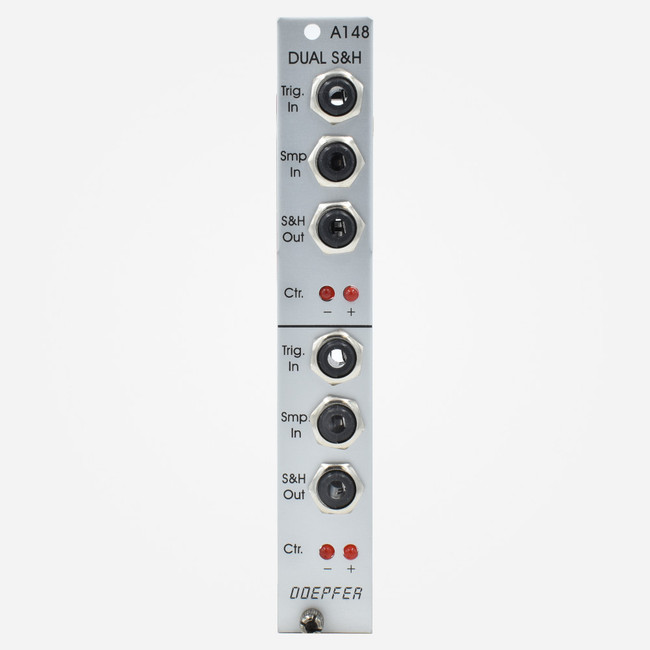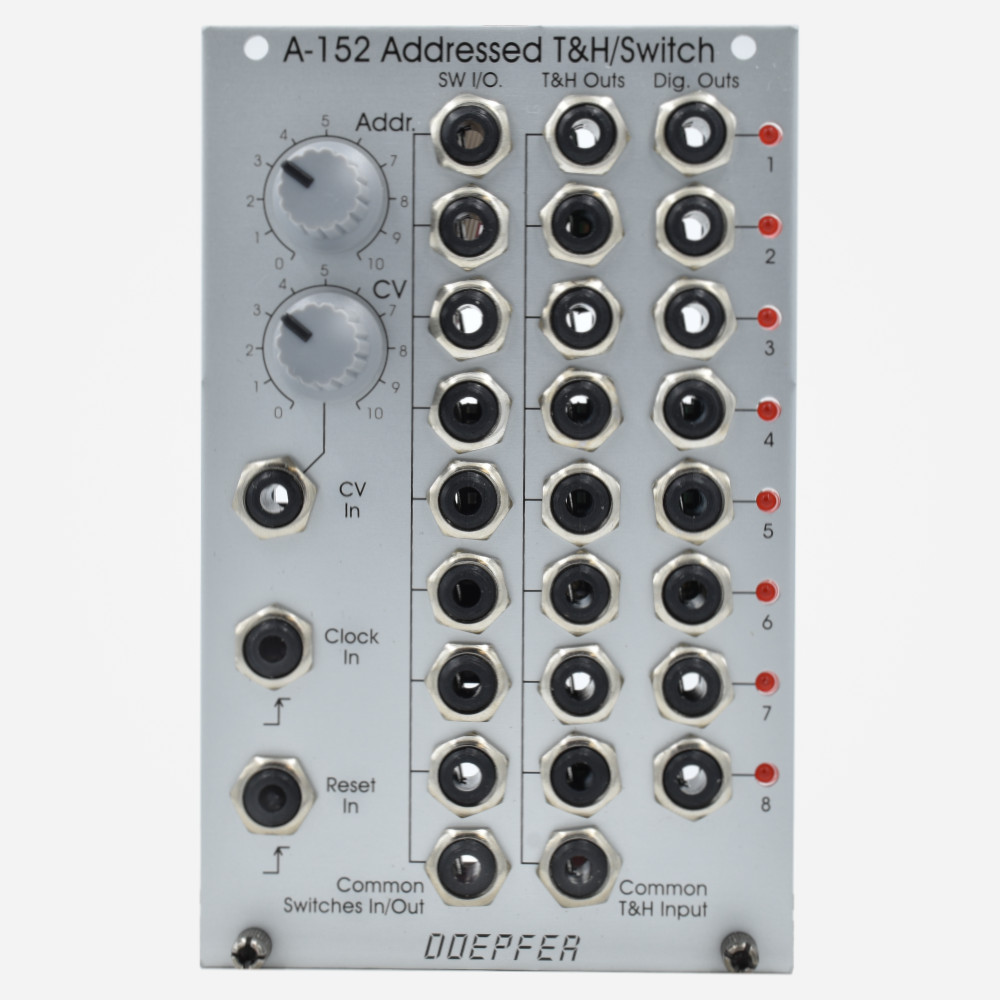The Doepfer A-152 module isn't the most obvious to use eurorack module, but modules like this were the reason we personally got into eurorack!
The A-152 contains three separate but interconnected utilities; the first is a 8 to 1 sequential or "addressed" switch. This allows switching from one input to 8 outputs or vice versa through triggers or by selecting the channel via CV. The next section is an addressed 1 to 8 channel track and hold. Patch a common CV to the track and hold input and when a step is selected it will pass the voltage, but when the step is deselected it will hold the last voltage level it had received. This allows use for creating cannons and other shift register type effects. The final section is the digital outputs, which are gates that go high when a stage is selected. When the a152 is clocked it allows use as a clock divider or sequential clock, and outputs can be patched to the reset to shorten the step count. When stages are addressed via cv, this provides a CV to gate interface or can function as a multi-level comparator. Super interesting and useful module for complex patching! Per Doepfer:
"Module A152 is a very useful switching and T&H module. It combines a voltage addressed 1-to-8 multiplexer and 8 fold T&H that can be used as kind of an analog shift register too. The active in/output is displayed by a LED. The digital output of the currently addressed step outputs "high". The remaining digital outputs are low.
Instead of voltage control even clock/reset controlled addressing of the active step is possible. The rising edge of each clock signal causes an advance to the next state. The rising edge of the reset signal resets to step 1.
Basis principles: The sum of the voltages coming from the manual Address control and the CV input define the currently addressed step of the 3 sub-devices. If the module is controlled by clock and reset the control voltage has to remain unchanged as the CV control has priority over the clock/reset control (e.g. simply turn the CV control fully counterclockwise and do not touch the Address control knob).
Sub-device #1 is the bidirectional 8-fold multiplexer (kind of an electronical 8-fold rotary switch). Bidirectional means that it works into both directions like a mechanical rotary switch: the common socket may work as an output that is connected to one of the 8 inputs that are e.g. connected to modulation or audio sources. But the common socket may even function as input. In this case the signal applied to the common socket is output to the currently addressed single socket. The voltage range of the in/outputs to be switched is the full A-100 voltage range -12V....+12V. All A-100 signals can be switched without any restrictions.
Sub-device #2 is the addressed 8-fold T&H. The signal at the common T&H input is connected to the addressed T&H output. As soon as a new output is addressed the last voltage is stored at the output (Track&Hold function). The T&H section of the A-152 allows the emulation of the "toggling T&H" function of the Buchla module 266 "Source of Uncertainty". Only the first two T&H outputs of the A-152 are required for this application. This unit can be used also as kind of an analog (shift) register. The difference to a "real" analog shift register is that the sampled output voltages are not shifted to the next output but remain allocated to the same output. But in some cases (e.g. controlling the pitch of 3 VCOs by 3 output voltages of the A-152) the result is the same.
Sub-device #3 is the digital output section. The digital output of the currently addressed turns to "high". All other digital outputs are low. The digital outputs can be used to trigger e.g. envelope generators or to control the reset input in the clocked mode to reduce the number of addressed stages.
Remark: In contrast to the Sample&Hold (see S&H A-148) the output voltage follows (i.e. tracks) to the input voltage as long as the corresponding stage (1...8) is active. Just when the stage is deselected the last voltage is held.
Remark: The clock signal that is fed into the Clock In socket has to be GND referenced to the A-100 frame. The reason for this is a recognition circuit at the clock input that is used to decide if the module is clock controlled or voltage controlled. For this recognition the GND pin of the Clock In socket is used. If an external clock signal is used (i.e. not coming from a module mounted into the A-100 frame where the A-152 is mounted) the GND reference is missing and the recognition circuit does not work (with the result that the clock input does not work). But there is a simple workaround: as soon as both systems are connected by means of any other patch cable that way the GND reference is established.
For more detailed information please look at the English user's manual: A152_man.pdf
Technical note: To protect the electronic switches in case of an unsuitable patch (e.g. connection of two outputs) a 1k protection resistor is inserted into the O/I line of each switch of the switching unit (left socket row). If control voltages used for VCOs are switched this may cause a small voltage drop and lead to undesired audible detuning. For this application we recommend to insert a CV buffer between A-150-8 and the VCO(s), e.g. A-180-3, A-180-4 or the Precision Adder A-185-2. Integrating the buffers into the module A-152 is not possible because this would ruin the bidirectionality of the switches.
The "Common T&H Input" socket can be normalled by jumpers to the "Common Switches In/Out" socket, i.e. the common T&H input is connected to the common switches In/out socket as long as no plug is inserted to the "Common T&H Input". This allows a multiplexed T&H, i.e. each T&H output has a separate signal to be sampled.
It is also possible to modify the T&H outputs for S&H function. If S&H (Sample&Hold) is chosen the voltage applied to the common input is sampled immediately when the output in question is adressed. T&H (Track&Hold) is similar but in this case the output follows the input as long as the output in question is addressed. The voltage is stored not until another output is selected. The modifiation is described on the A-100 DIY page.
Technical note: The T&H function is realized by pure analog circuitry (electronic switch followed by a holding capacitor and buffer). Consequently the output voltage drifts a bit in the holding state because the capacitor is discharged by parasitic resistors. The drift is about 200mV/minute but depends upon different conditions (e.g. humidity, temperature, tolerances of the electronic parts). For the storage of control voltages over a longer time used to control the pitch of a VCO the module is suitable to only a limited extent."
Specifications:
16HP
45mm Depth
40mA @ +12v
20mA @ -12v






